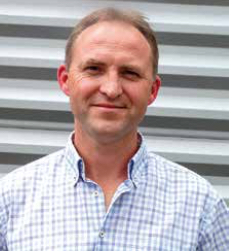
Grimaud Freres has grown its footprint steadily in Asia, particularly in Vietnam during the past 10 years. Yann Le Pottier, managing director, and Jerome Boucherot, export sales director, recently shared their opinions with Feed & Livestock Magazine on the dynamics of global demand, selection strategies to sustain the leading position of Pekin Star 53, and the need for breeding operations in strategic locations worldwide to ensure a steady supply.

Q: What is the growth rate of duck meat and breeders globally, and who is the world’s largest consumer of duck meat and duck breeders?
Duck meat production is steadily growing at about 2% worldwide. Market growth is mainly in Asia. The biggest producing country for Pekin duck, as for most protein, is mainland China, with nearly 80% of the world duck production, followed by Korea, Thailand and Vietnam.
These above countries are supplied with grandparent breeders which are then multiplied for the production of commercial ducks. The biggest consumer per capita is France at around 3.5 kg, then Taiwan, China, followed by Malaysia, Hungary and Bulgaria. China was ranked number five consumer in 2011, according to the International Poultry Council.
Q: What is your current market share globally and in Asia?
Grimaud Freres is supplying around 25% of the global Pekin duck market, (excluding mainland China), and reaching over 80% market share in some significant duck producing countries like Vietnam, for example.
Q: Do you see substantial growth in demand in Eastern Europe and Germany for broiler ducks and duck genetics?
Germany used to be a big producer of Pekin duck in the past, however due to worldwide competition, production has shifted gradually to Eastern Europe. Poland, Hungary and Bulgaria have become the heart of duck production in Eastern Europe. This production is partly consumed locally but mainly exported to Europe.
Q: What are the trends in production and demand?
Depending on the type of duck, duck is getting more competitive worldwide so we see competition between European countries in order to produce at cheaper prices and therefore there is no regulation of production. We can observe also an increasing percentage of duck meat movement between Europe and North America or between Asia and Europe. With such a big production zone, there is intense competition to be the first to produce and to market whether it is for whole ducks or for cut up/cooked duck meat. Duck meat is a growing alternative to chicken and other meat.
Q: As for global market developments and market penetration in Asia, which countries do you plan to invest in with regard to marketing or setting up breeding operations?
Grimaud Freres decided to invest in breakthrough R&D technologies five years ago to develop the performance of our flagship Pekin product: the STAR 53. It’s been a long time to wait to obtain results, but we are now ready to announce remarkable progress that will significantly improve our position in all the main markets of Asia.
Grimaud Freres set up its rst operation in China 20 years ago and since then we have never stopped investing in the country. For example, we invested last year in a new operation for duck production in Shaanxi province (near Xian city).
In addition, 2019 is a particularly important year for Grimaud Freres in Asia as we celebrate the 10th anniversary of our subsidiary in Vietnam. This is a perfect opportunity to highlight the great work of the Grimaud Vietnam team, which is experiencing remarkable growth since its opening and now supplies around 85% of Vietnamese breeders.
Q: Will there be more technical and marketing teams in the eld?
One of Grimaud Freres trademarks has always been high quality support and a very close proximity to our customers. Future commercial development is therefore necessarily accompanied by a strengthening of our technical teams in the field to continue to guarantee that quality of support.
Q: Given the outbreak of avian influenza, how do you manage logistics to overcome these constraints?
Reinforcing our safety standards is a daily task and a constant obsession of Grimaud Freres in order to avoid epidemic episodes.
Groupe Grimaud is helping the French government negotiate new conditions for exports, especially those based on zoning, which is a major issue for the French duck industry. In addition, beyond the guarantee that we are always at the forefront of sanitary measures, we now have breeder flocks spread out in 20 different compartments to allow exports in case of zoning issues.
Secondly, Grimaud Freres has developed specific partnerships with long-term clients in order to use these clients as a production base if France is blocked by an avian influenza crisis. One base is located in Australia and another is in Canada. These specific measures guarantee our customers continuity in deliveries whatever happens. It is an important guarantee to support the confidence they show in us.
Q: As one of the world’s top poultry genetics companies, what is your view on animal welfare and what practices are you recommending for your clients?
Animal welfare is a daily concern first in our company, as evidenced by our EFFABAR certification (regarding welfare practices at the selection level), and the one by the French poultry breeders syndicate which has also established welfare standards.
Beyond these two certifications, and with animal welfare being a common value shared by all Groupe Grimaud companies, we have drawn up our own “Natural Concept” charter that combines animal welfare, well-being of people and the global concept of sustainability in animal production.
The priorities of people are not the same, because it depends on whether you are in a very developed or in an expanding country. The former advances the cause of animal welfare while the latter is primarily concerned with feeding people. As a world leader in poultry genetics, our role is to always tailor our support for animal welfare based on our customers’ specific issues.
Thus, our technical teams can build partnerships with our customers based on different criteria according to their expectations: biosecurity, livestock management, performance and profitability, or animal welfare.
Genetics
Q: What are the priorities in your selection program for the sire and dam?
Duck is becoming more and more popular, and therefore more and more competitive. With feed accounting for more than 50% of production cost, our efforts are aimed first at the Feed Conversion Ratio (FCR). The aim is to produce a bigger duck with less feed consumption in a shorter time with a good meat yield.
Whole duck accounts for a great part of duck production, so emphasis is also put on the fattiness of the duck to supply a nice, crispy duck to the end consumer.
Grimaud Freres’ aim is to supply as many STAR 53 breeders worldwide as possible; therefore, the breeders must offer good productivity and fertility for our customers.
Q: What are the genetic improvement and performance goals, such as FCR, ADG, fillet and liver yield, breeder performance, hatching eggs/female breeder, and welfare traits to be seen in 2020-2025?
Thanks to Groupe Grimaud’s GENETECH (a multi-species R&D platform allowing the sharing of the latest technologies, know-how and shared investments) and increasing pressure in our selection programs, Grimaud Freres will soon be launching new breeders and better performing broilers in the Pekin duck market. These improvements focus of course on the classical production traits detailed above. New traits such are rusticity and nervosity are also traits that we are working on at present with the new breakthrough technologies.
Q: With rapid developments in genetics, will you update your management guide for hatchery, nutrition and management?
Grimaud Freres, because it is part of Groupe Grimaud, has an R&D team with unparalleled ability in duck genetics that shares know-how, methods, ideas and technologies among a group of more than 30 experts, engineers and researchers within the Group. We also rely on the expertise of the Group’s nutritionists to evaluate and adapt diets for our most recent products. In addition, our management guides are reviewed when deemed necessary in order to adapt to the reality of the field.
Q: What are the new products to be launched by 2020, and what traits have been improved compared with their predecessors?
In terms of Pekin duck, FCR last year improved by 40 grams and overall bodyweight increased by more than 50 grams. Thanks to our CT Scan and FCR testing station, we expect even greater improvements within the next two to three years both in terms of FCR, bodyweight and meat yield.
